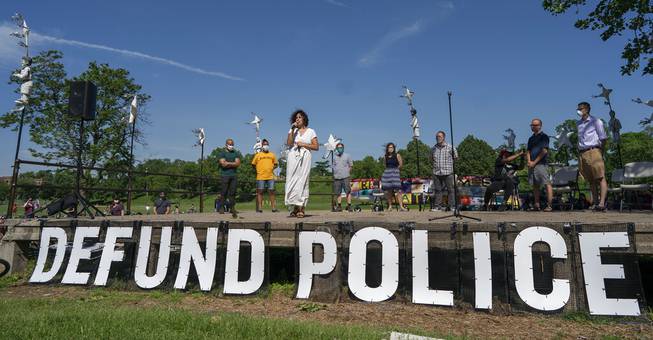
Jerry Holt / Star Tribune via AP
In this June 7, 2020, file photo, Alondra Cano, a city council member, speaks during “The Path Forward” meeting at Powderhorn Park in Minneapolis. The focus of the meeting was the defunding of the Minneapolis Police Department.
Friday, Oct. 22, 2021 | 2 a.m.
View more of the Sun's opinion section
In yet another attempt to create an alternate reality and turn Americans against each other, the extreme right blames the police reform movement for last year’s alarming increase in murders in the United States.
This is a patently false narrative, and one that is easily disproved.
The right would have Americans believe that demands to “defund the police” resulted in mass reductions in law enforcement forces and in turn sent the national crime rate skyrocketing, mostly because of increases in cities run by Democrats. But here’s the reality:
• Pinning the elevated homicide rate solely on police reform totally ignores the string of factors that made 2020 such a volatile year: the devastation of the pandemic, sweeping job losses, social upheaval, a near collapse of our democracy, political tribalization, a breakdown of general civility and other stress points that created extreme tensions and sparked numerous outbreaks of violence.
• The homicide rate went up even in cities that increased spending on law enforcement. Among them were Houston and Nashville, Tenn., both of which are led by Democratic mayors.
• In communities that adopted police reforms, most force reductions were modest. In Minneapolis, for instance, the city shifted a mere 5% of the police department’s budget to programs supporting mental health and violence prevention, while also spending $6.4 million to offset a wave of officer retirements following George Floyd’s killing.
• While murders were up substantially, the rate of several crimes went down last year.
• The overwhelming majority of American cities didn’t embrace the police reform movement — certainly not enough to explain the nationwide increase in the murder rate.
The truth is that changes in crime rates anytime and anywhere involve numerous factors, which is the case with last year’s nearly 30% rise in murders. For instance, there was also a massive increase in gun sales last year, which by November of 2020 had already broken the previous record for annual sales set in 2016. But while bigger stockpile of guns may have contributed to more homicides, it was still only one part of a much larger set of circumstances affecting the crime rate.
Meanwhile, studies have conclusively shown that increases in police spending do not reduce crime in and of themselves.
In scapegoating the police reform movement for last year’s rise in murders, the Republican Party’s irresponsible leadership and their propagandists in right-wing media are agitating their base supporters against anyone outside the party. Their behavior is divisive and racist, given that the police reform movement was led by Americans of color.
It also does nothing to address the very real problems that the “defund the police” movement seeks to solve, such as patterns of police violence against people of color, inequality of policing practices between white and non-white communities, and fundamental societal problems such as mental health, poverty and substance abuse that contribute to crime.
The constructive way to address police reform would be to talk about how communities could balance the need to maintain adequate police forces for protection with the equally critical need to improve police training, accountability and protocols. Another key part of the discussion involves investment in social services that could help maintain the peace and reduce interactions between the police and community members.
Everyone wins from these conversations, including law enforcement.
But unfortunately, the rising murder rate last year opened the door for the extreme right to pressure decision-makers into steering away from discussions about police reform. Several cities abandoned discussions on the topic or veered the other way and increased spending on police.
That’s too bad, because the status quo isn’t healthy. The conversations that rose to a crescendo during the Black Lives Matter protests need to keep happening, because the fundamental problems that were the focus of those protests haven’t been solved.
And contrary to the fiction coming from the right, the solution to rising crime isn’t simply hiring more police. If that were the case, we would have solved the problem long ago.
